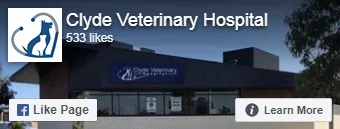Maintaining Healthy Body Weight for Dogs & Cats

By Dr Irene Mitry
We’ve all heard about the modern childhood obesity epidemic, and a lot of time and money has been devoted in public policy to tackling the problem.
But did you know that studies have shown a similar proportion of the furry members of our families are facing a similar epidemic?
A recent Australian academic study showed that as many as one third of cats and nearly half of all dogs in Australia are overweight or obese. When you consider our childhood obesity rate is around 28%, it appears we actually have a bigger public health issue with obesity in our pets, and it is time this issue received more attention.
So, as part of Clyde Veterinary Hospital’s March Weight Management Month, I thought it was a good time to look at a few best practices in weight management that you can start implementing today to give your pet their best possible chance at long term good health.
Weight is a Predictor of Health Issues in Later Life
Studies have very clearly established that overweight dogs and cats face a significantly shorter life expectancy than their properly weighted counterparts.
Studies have shown that dogs fed 25 percent fewer calories than their free-fed littermates lived nearly two years longer, showed fewer visible signs of aging, and enjoyed an extra three years of pain-free mobility before developing canine arthritis.
Overweight dogs and cats face an increased likelihood of a huge range of related conditions including osteoarthritis, pancreatitis, type 2 diabetes, high blood pressure, heart and respiratory disease, kidney disease, disc disease, ruptured cruciate ligaments, hip dysplasia, other forms of joint disease, surgical complications, compromised immune systems, and several types of cancer.
Owners also need to consider that an overweight dog or cat is going to suffer a reduced quality of life for as long as they remain overweight, not to mention the significantly higher veterinary bills they are going to face over the entire life of their pet.
For that reason, spending a little bit extra on a high-quality diet for your dog or cat can actually save you money over the longer run.
Calibrating Food Equivalents for Dogs and Cats
We’re mostly quite accustomed to managing our own personal diets to maintain a healthy body weight, but it can be difficult to translate the same practices to our pets, given the average human weighs about 20 times as much as the average cat’s weight and still several times as much as the average dog.
If a 4kg cat gains just 800 grams of weight or a 32kg dog gains 6 kilos, it’s important to realise that is the equivalent of a 63kg woman carrying an extra 11kg around! This is why achieving successful weight loss can be a life-transforming experience for both pets and their owners.
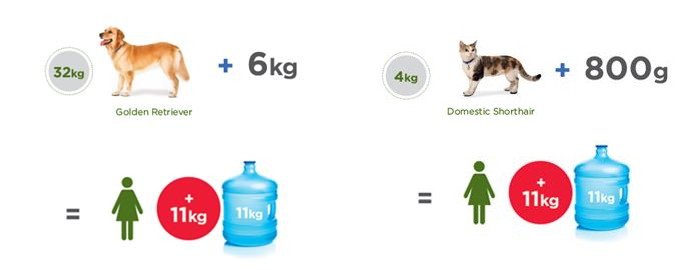
Similarly, feeding a 4kg cat just 14 grams of excess cheese is the calorific equivalent of a hamburger and small fries in human terms – an entire meal – and for a 15kg dog, 28 grams of cheese is the equivalent of a whole human hamburger.

We all love our pets and don’t want to deprive them of their enjoyment and our affection. Let’s face it, food is love! Maybe that’s why around 90% of dog or cat weight loss programs fail, and regaining lost weight is so common.
It’s important that pet owners understand how to make these relative calculations. The point is that even a few little treats a day can easily tip your pet’s calorific intake above the ideal level. While rewards can be an important part of effective behavioural training for dogs, in particular, it’s extremely important that you don’t go overboard with the treats.
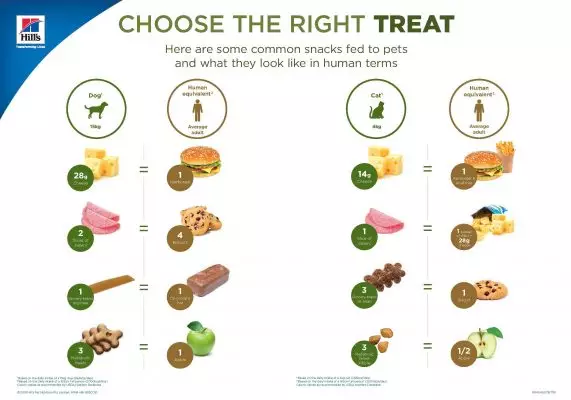
Your pet’s weight is essentially governed by two broad factors – their dietary intake and their level of activity. This is why elderly dogs and cats can be particularly susceptible to developing weight problems as their levels of natural activity start to decline with age, but their appetites generally don’t.
It’s therefore particularly important for owners of elderly pets that they are extra vigilant for any changes in their weight condition. Owners of elderly pets should also have less need for offering their dog or cat treats from a behavioural viewpoint, as the animal’s habits will almost certainly be fully established.
How Do I Know if My Dog or Cat is Overweight?
It’s essential to have an effective weight and diet management regime in place for your dog or cat from an early age, and to recognise the signs when they are tending towards an unhealthy weight, so you can respond effectively through diet and exercise.
But your dog or cat’s ideal weight obviously varies widely, depending on factors like the species, size and age of the animal. The following graphic lets you estimate their Body Fat Index, based on a visual assessment of their body shape, which should give you some idea of how serious an issue you are facing.
Higher BFI scores are correlated with an increased risk of health complications, so the higher your pet’s BFI, the more urgent it is that you take some immediate remedial action.

Another useful test is to run your fingers gently over your dog or cat’s ribs and spinal area. If the bones can be felt in a similar condition to running your fingers over the knuckle area in your forehand, you should consider your pet to be approximately within the target BFI range.
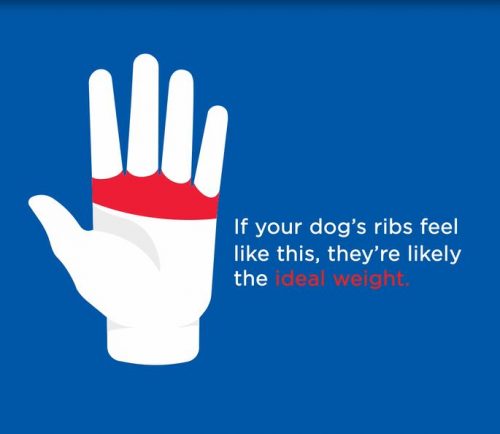
It’s not an exact science, but the signs of an overweight dog or cat are for the most part fairly obvious – including difficulty in feeling their defined ribs, spine and waist, or a sagging abdomen. This short video from the good folks at Hill’s Australia walks you through the core things to look out for.
Tips for An Effective Pet Dietary Management Regime
When people want to lose weight, they usually do so by eating healthy food in the right amounts and exercising regularly. The same is true for our overweight dogs and cats. They need specific foods to help them lose weight without missing out on the essential nutrients they require for good health.
1. Feed overweight dogs and cats more protein and fewer carbohydrates or high-fiber foods.
The most important factor when considering a weight loss diet for your pet is the ratio of carbohydrates to fats and protein – this matters far more than the absolute number of calories do in impacting their weight.
Many “weight-loss” diet pet foods are actually high in carbohydrates, but low in fat and protein, which is completely the wrong ratio if you’re looking to bring their weight under control.
Dogs, in particular, thrive on a high-protein diet, which builds lean muscle, and don’t actually need carbohydrates at all. The ideal pet weight-loss diet is high in protein, low in carbohydrates, and moderate in fat, which will help satisfy their appetite.
Fiber is the indigestible part of carbohydrates, and so increased fiber content will not help your dog feel satisfied, and too much fiber can actually interfere with their nutrient absorption. Grains are a common source of fiber, and so many grain-free foods are high in protein and low in carbs, which can make them effective foods for weight loss so long as they don’t contain too much fat.
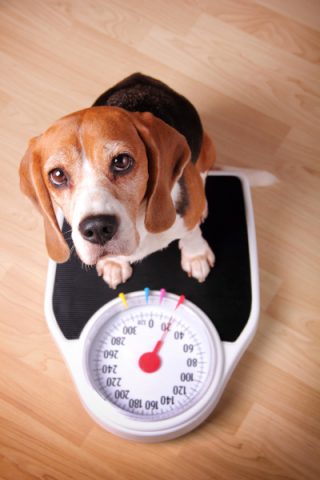
2. Feed overweight cats and dogs the right fats.
Recent studies have shown that the omega-3 fatty acids EPA and DHA, as obtained from fish oil are effective in promoting weight loss and helping dieters feel more satisfied.
Cats should be eating a varied diet which includes a sizable percentage of fish already, but dogs routinely have less access to these fantastic natural oils and often benefit from the addition of fish oil to their diet.
We recommend fish oil that provides 1 to 1.5 mg combined EPA and DHA per pound of body weight daily for healthy dogs, or up to 3 mg for dogs with health problems (such as heart disease, kidney disease, cancer, arthritis, allergies, and other conditions causing inflammation or affecting the
immune system). Some cod liver oils, such as Carlson Norwegian Cod Liver Oil with Omega 3s, provide vitamins D and A for additional health benefits.
When adding oils to your overweight dog or cat’s diet, keep in mind that oils are pure fat, adding more than 40 calories per teaspoon. Label directions for many liquid fish-oil products are higher than they should be, adding too many calories to your pet’s diet.
3. Reduce their food portion sizes.
This is one area where we urge pet owners to hasten slowly. Whilst simply reducing their calory intake might seem like the most obvious course of action, taking this approach rather than using a specific weight management food means you will be reducing their intake of beneficial proteins and risking reducing essential nutrients such as calcium and essential fatty acids. This is not good in the long term and can lead to malnutrition.
Reducing your overweight dog or cat’s level of food intake t
oo suddenly risks changing their metabolism, making it harder to lose weight and easier to pack it back on. Slow, steady weight loss is more likely to result in long-term success.
Instead of making drastic changes all at once, cut your overweight dog or cat’s food back by about five percent and feed them that slightly smaller amount for a week or two. Weigh your pet at the beginning and end of the two weeks.
If they don’t lose weight, we suggest reducing their food by another five percent and continuing at that amount for another one to two weeks. Keep gradually reducing the amount of food until your dog begins to lose weight, then continue feeding them that amount as the new normal.
If you switch to a food that’s considerably higher in protein and fat than your current food, cut the quantity by up to one-third, as foods that are more nutrient-dense will provide more calories in smaller portions. Even though the total amount your pet receives is less than before, they will likely be feeling more satisfied at the end of their meal because of the higher fat content.
Feeding smaller portions more often can help your dog or cat feel less hungry. Replace some dry food with canned or fresh, high-protein food so they think they are getting something special.
Try putting your dog’s meals in a Kong, Buster Cube, or other food-dispensing toys so he has to work for them, leaving him feeling more satisfied. Freeze wet food, or mix dry food with nonfat yogurt in a Kong toy to make the meal last even longer.
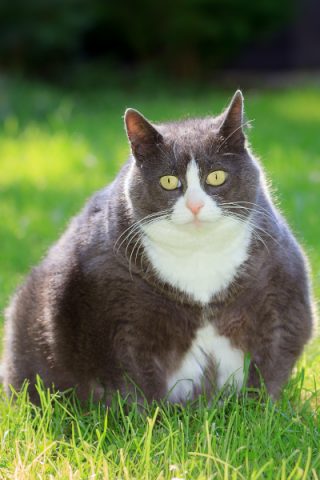
4. Measure out everything that you feed them
We strongly recommend that pet owners should routinely be accurately measuring the portions they are feeding them. As we’ve seen above, even a small physical quantity of food above their normal amount can actually represent a significant increase in calories.
If possible, use an electronic scale or standardised measuring cup so you can be consistent and accurate in the amounts you are feeding them, plus easily make the necessary reductions in quantity.
5. Make your pet’s weight loss a family project.
Measuring everything and writing it in a diet book or food log helps family members all understand just how much your pet is eating. and the consequences of having an overweight dog or cat. Feeding a small dinner won’t help if they are also getting leftovers, snacks and treats all day from other family members.
Discuss your pet’s diet plan with everyone who feeds them and get their cooperation. You can give each family member a specific number of small training treats to reward the dog with, and encourage everyone to focus on games, walks, playing fetch, and favourite activities as calorie-free rewards that will keep your dog motivated.
6. Weigh them regularly
Smaller dogs and all cats can be easily weighed on a small baby or postal scale, and most veterinarians will have a walk-on scale that accommodates dogs of all sizes, so if your large dog is willing, you should take advantage of this.
All this March 2020 at Clyde Veterinary Hospital we are offering FREE Weight Management Checks and Action Plans for dogs and cats, so please feel free to stop by the clinic at Selandra Rise shops and get your dog’s weight measured accurately plus a contextual weight action plan based on those findings. See the end of this article for more information.
We recommend aiming for weight loss regime for overweight dogs or cats of three to five percent of body weight per month, or one percent per week, until they are back down to a healthy weight.
Once they begin losing weight steadily, you can go longer between weigh-ins, but we suggest rechecking their weight at least monthly to make sure you’re still on track. It’s easy to slip back into giving too much food and not notice until your dog has gained back a lot of weight.
Caloric needs can also change over time as your dog ages, after neutering, or if his activity level varies seasonally. If you’re weighing your dog regularly, you’ll be able to catch and correct any weight gain before you have a bigger problem.
7. Rethink the treats you feed them
Treats are an important part of effective behavioural training, especially for dogs. Fortunately, dogs care more about the number of treats they receive than the size of each treat, so it’s more rewarding for a dog to receive several small treats than one big one.
Try to avoid treats that are high in fat and calories, such as hot dogs or peanut butter. Instead, try raw baby carrots, zucchini slices, other crunchy vegetables, or small slices of apple, banana, or melon. Make your own treats out of low-fat organ meats like heart or liver. Grapes, raisins, and anything containing xylitol (a sugar substitute) should not be used, as they can be toxic to pets.
Another good strategy is to feed some of your pet’s dinner as treats during the day. Just be sure to reduce her meal size accordingly.
8. Find the right edible dog chew.
Dogs love to chew, and if you can find a low-fat, long-lasting chew, it can keep your dog busy, satisfied, and out of caloric trouble. Dried tendons, steer sticks, and similar chews work well unless they’re small enough for the dog to swallow.
Rawhide or fresh, raw bones can also be used for chewing. Bones that are too big for dogs to get between their molars and chomp down on, such as knuckles, are less likely to cause problems than marrow bones, which are filled with fat and therefore not a good choice.
Tips for An Effective Exercise Regime for Cats
Enticing your dog to get active with a walk around the block or a game of fetch is a no-brainer and a fairly common pet health practice. But when it comes to cats, many people don’t realise the value or the possibilities of exercise.
Kitty workouts can help to keep cats healthy well into their old age. And though a cat won’t exercise as readily as a dog will, there are a few strategies that will help you keep your cat active and mobile.
Try these 10 cat exercise tips:
- Pair up, exercise partners. Since a cat won’t respond to your requests to play as easily as a dog might, it’s often a good idea to keep cats in pairs. A pair of cats who get along well will get plenty of exercise through their own wrestling and chasing games. And of course, it’s easier to introduce two cats at the same time than a second cat later on.
- Try a cat tower. The multi-tiered “cat towers” are another good way to ensure that your cat will have plenty of places to play and areas to climb for a good workout. You can even place small treats in different parts of the tower to encourage climbing and playing.
- Keep plenty of toys around. Because cats tend to keep to themselves much more than dogs, the best strategy for cat workouts is to give them plenty of options in the form of toys. And these don’t have to be expensive toys – you can use everyday household objects as toys to encourage cats to exercise.
- Create a hockey rink. To make things even more interactive and fun, Nelson recommends putting a ball in a large cardboard box or the bathtub to create an instant “hockey rink” for your cat. As the ball goes flying off the walls (and the cat goes flying after it), you’ll get some laughs and your cat will get some much-needed exercise.
- Have fun with lasers. Speaking of laughs, few things will entertain you more — or have your cat moving faster — than a laser pointer on the end of a pen or levelling tool. Laser toys are often good entertainment, but follow it up with a real toy the cat can catch to avoid fixation and frustration over never being able to catch the light beam and be sure to never shine the beam directly into the cat’s eyes.
- Give your cat a wand. Get one of the flexible wand-style toys with a feather, mouse, or other diversions on the far end. This is a great cat exercise, a good follow-up to the laser and extremely satisfying for the big hunter in your cat. You can make it more challenging by running the toy up and over the sofa or up and downstairs to increase the exercise intensity.
- Use catnip wisely. Catnip is a useful tool for getting your cat to exercise, but be cautious to use it only in the right situations. Not all cats respond to catnip, and of those that do, a few will become aggressive. Catnip is obviously not a good play candidate for such cats. And remember, you should never give your cat catnip before a stressful event, such as a trip to the vet.
- Create an agility course. If your cat is extremely energetic and agile, try some cat agility exercises. Include a number of obstacles, such as bars to jump over or tunnels to pass through, which push your cat both physically and mentally. There are loads of great articles online suggesting how best to do this, of which this is an excellent example.
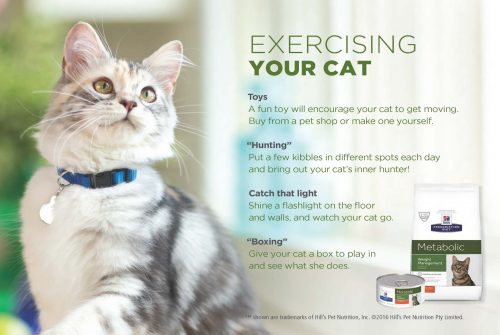
Tips for An Effective Exercise Regime for Dogs
- Take a hike. Well, a hike is a great idea, but if you are not used to strenuous exercise, start with a walk, and build from there. Many of us are pressed for time. So, if you are running late in the mornings, try to get up just a bit early — if possible. You can take a 10-minute walk with your dog. If your schedule allows it, try to get in three walks a day, and make one at least 20 minutes.
- Visit the dog park. If possible, walk to the dog park. When you get there, toss a ball around with your dog. Both of you will get some exercise.
- Go for a swim. Swimming is a low-impact exercise that you and your dog can do.
- Jog or run. Find a track that welcomes dogs and make sure you have comfortable running shoes. That is all you need for this cardio workout. Bring a water bottle and foldable bowl so you and your dog can rehydrate.
- Tug-of-war. Play a game of tug-of-war with your dog. It can help build your upper body strength and your dog will enjoy spending time playing with you.
- Play catch. Whether it’s a ball, a Frisbee, or his favourite toy, go outside and play a game of catch.
- Resistance walk. This is great for all kinds of weather. Try to walk your dog in the snow, on the sand, in shallow water on the beach, or on a leaf-filled trail.
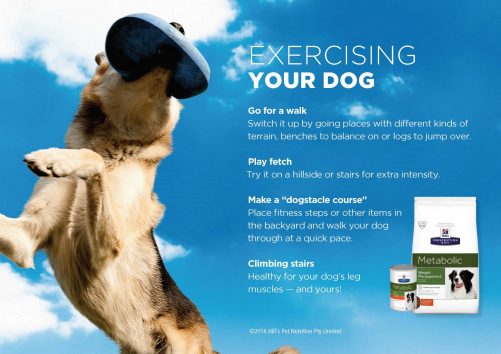
Book an Appointment Today


